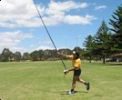- News
- Air conditioned holiday house at Kalbarri for rent to the public and club members at competitive rates. Read more
- Updates to this website are all listed in What's New or use Search
Alvey Sidecast reels come in several sizes and models. The smaller ones (5 inch/125mm and smaller) make good distance casting reels but have a slow retrieve. The medium to large sizes (6 inch/150mm upward) are very, very good reels for most sorts of beach, rock and reef fishing from light to very heavy. An Alvey reel is not really suited to lures needing a fast retrieve, but it can be used for lures with action at slow speeds, such as poppers.
Over the years, we have been asked for advice on things that people have trouble when casting and using Alvey Reels. These include:-
1. How to manage line twist on an Alvey reel
2. How to wind the line on to the reel correctly
3. How to hold the line and hold and rotate the spool for casting
4. How to control the line when casting, especially in windy conditions
5. Choice of the rod and how it is built
7. Accessories - Rod bucket and belt
It's all very simple really when you apply a bit of logic and other people's help and experience to this.
We hope you find these tips and explanations helpful.
All these explanations and photos apply to Alvey reels which are wound with the right hand. Reverse everything if you use a left hand Alvey.
Once you work out the methods and apply them, all the problems disappear and you can appreciate the Alvey Reel for what it is: a super reel, strong, simple, doesn't mind water and sand, easy and reliable and a joy to use for beach, surf, cliff, rock and reef fishing, especially when trying to stop the big ones. And you will be able to do all this in the dark if you need to.
If you are in the Perth area, then all this can easily be shown to you at our Dry Casting days. This is one topic where a simple demonstration is worth a lot of pictures and words. See the Dry Casting pages for more details and links to the dates and locations of our Dry Casting days.
Line twist is the big problem for many people when using Alvey Reels. Some people stop using the reel or give away the reel in sheer frustration. The solution is simple.
Line twist is fundamental when casting Alvey reels. When casting, the spool is turned sideways at right angles to the rod and the line comes off the spool in a way that will put in two full twists for every metre of cast (with a 6 1/2 inch Alvey reel.) When the spool is turned parallel to the rod to wind the line back on, these twists are not removed. To see this twisting effect, put some flat tape on the reel and peel it off the way the line comes off when casting.
So line twist is always there when using an Alvey, but it doesn't have to cause ANY problems if your rig and your actions let these twists unwind themselves.
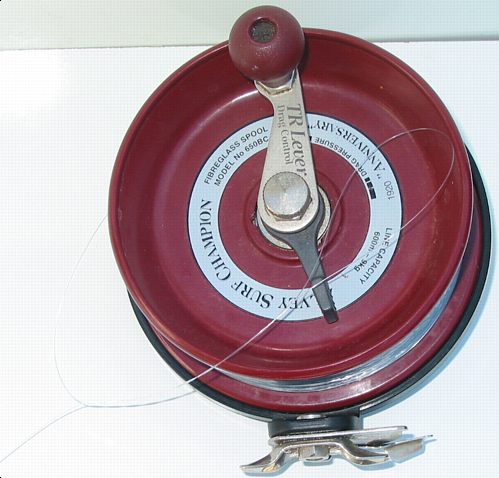
Line twist causing loops in the line.
How will you know when line twist is becoming a problem? Believe us! - if you are not managing the line twist - it will become a problem that will get very obvious!
The first thing you will notice is that any time you let the line go loose, the line wants to form loops and twist around itself and stand out at right angles to the main line, as in the photo below.
This twist will get worse with every cast and soon the line will form these loops even when it is under some tension. You'll also know when you've got line twist because the line will start to slap on your top arm (your right arm) as you cast, rather than just peel off the spool and go smoothly up to the first runner.
Casting line with twists in it causes big problems as the loops of line come off the spool and head towards the first runner. The line tries to form those twisted sections which stand out at right angles from the line. They can wrap around the reel handles and your hand. Once this happens you are in for big trouble unless you do something about it before the next cast.
Instead of the line going smoothly through the first runner, the line has loops which actually go past the first runner and sometimes can wrap around the runner. More later on the type of runners and placement which reduce or prevent that....
Removing Line Twist. If you have twisted line, the simple way to remove the twist you already have in the line is to run it out on the beach, open area or sports ground and wind it back onto the reel without anything tied on the end of the line. Hold the line between your fingers as you wind in to force the twists down to the loose end. You may have to do this more than once, even several times because the loose end may twist up and not spin freely. Then you must prevent the line twist from building up again.
Preventing Line Twist is THE answer, and it is easy, it becomes automatic and is never a problem when you use Alvey reels and follow these tips. It might sound complicated, but it's as easy as....
You MUST have an effective swivel above anything else in ALL rigs used with Alvey reels. But just having the swivel there isn't any good unless it can always spin freely and it does actually spin to release the twist.
The swivel will spin and release some twist as you cast out and while you are waiting for a bite, and possibly even while you are winding in, unless the line is under heavy tension. But the line has to be stiff enough to actually make the swivel rotate. Some lines are soft and hold the twists.
The stiffness of line comes from its diameter and material. Stronger/thicker line is stiffer, and some types/brands of line are much limper than others and some types are much smaller diameter for any given breaking strain than other types/brands. Softer, thinner, limper lines cannot and do not rotate the swivel as well as stiffer lines. But the twist is still there, and it is increasing with every cast unless you manage it.
As you wind the line in and feed the line onto the spool, you tend to push the twists down towards the end, so there will always be some twists in the end section of your line.
The real secret is that EVERY time you wind your rig back in, you take the weight off the swivel so that it can spin freely and do its job.
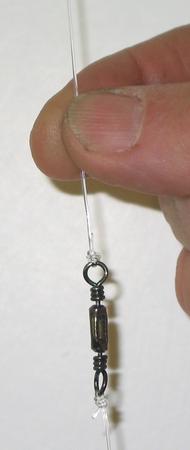

Left: Stage 1 of reversing line twist with fingers.
Right: Stage 2 of reversing line twist with fingers.
As you take the weight off, you will see the swivel spin many times and let out some of the twist so it isn't a problem. Doing this also makes sure that the swivel isn't locked up with sand, fine weed etc - which often happens when fishing in some areas.
Reversing the twist. It also helps to take the weight off the swivel with your left hand, then hold the line with your right hand just above the swivel. Start with the line between the tips of your thumb and your index finger, see left photo. Roll the line between your index finger and thumb to take some of the twists out, ending as shown in right photo. Do it so the swivel spins in the same direction as it does when it is removing line twist.
Do this several times. You can even put some extra "reverse" twists in the reverse direction to those put in by the next cast. When you cast out, these twists will distribute themselves along the line. This method is for an Alvey wound with the right hand. Reverse the twist direction for an Alvey wound with the left hand.
It's easy to do this when you check your bait or put a new bait on. If you're using a lure you need to swing the lure up, grab it and take the weight off the swivel. A rod bucket or pouch lets you have both hands free to do all this.
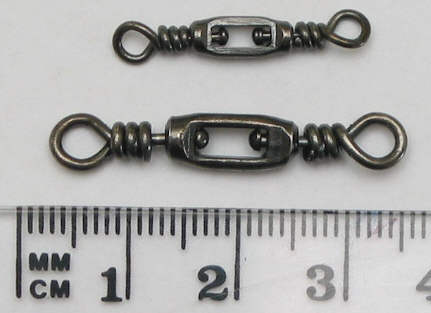
Box swivels for light or medium, and for heavy fishing.
Size and Type of Swivels. You might see tips about using very small swivels or special types or using two linked swivels. If you take the weight off after every retrieve and let the swivel spin, or force it to spin, it doesn't matter what type or size of swivel you use, and they don't have to be small unless you're using very light line. It is much more important to pick the swivel size for the strength you need in the rig, because some small swivels are not very strong.
Many people use box swivels on the top of all Alvey rigs. Being open, these don't seem to get jammed with fine sand as easily as some other types when beach fishing. These work extremely well.
You can try using special swivels such as ball bearing swivels - but whatever type of swivel you use, if it gets sand in or weed wrapped around and jams up, then the line twist will come back - and the first you may know is the line looped up and wrapped around a runner or a finger or some part of the reel - so check your swivel EVERY time you wind in.
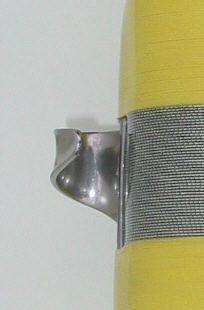
An Alvey "open" runner
The Alvey Open Runner. A rod used with an Alvey reel must have a special "Open runner" fitted about 550 to 600mm above the reel.
The Alvey open runner is provided to take most of the pressure off your left index finger, the finger which does the level winding, so the line doesn't cut in to your finger.
The open runner doesn't do the level winding and doesn't control where the line goes onto the spool except in a very general sense. Level winding is all done with the index finger of the left hand.
The open runner needs to be mounted around the rod a bit to the left of the bottom of the rod - as you look at it as you would hold the rod to retrieve line. In that position it always tends to feed the line towards the backing plate and away from the lip of the spool.
If the open runner isn't far enough towards the left, the line will slip out of it as you feed the line towards the backing plate side of the spool.
After controlling twist, the next most important things - no, not just important, they are critical - are level winding, keeping tension on the line and avoiding winding the line up the lip of the spool.
Level winding means winding the line on reasonably level across the spool. It is not just lots of nearly parallel lays of line on the spool, but also includes having enough crosses in the line so that it won't cut in between the layers underneath when it is under strong pressure from a fish.
Keeping tension on the line means never winding the line on loose.
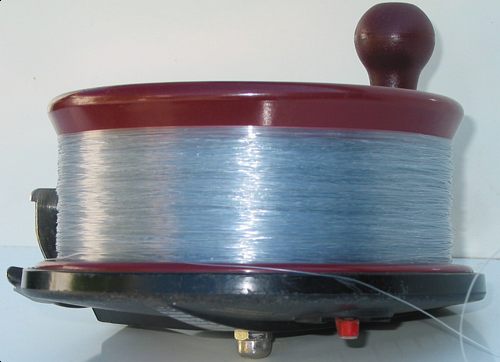
Line wound evenly and level on the spool of the Alvey.
Level Wind. The photo shows the line wound on tight and level across the spool. You will rarely or never have any problems with throwing loops if your line is wound like this.
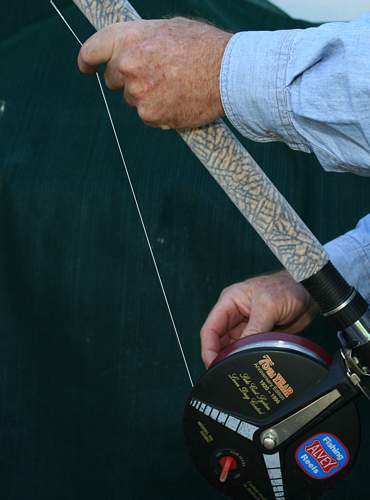
Line runs on the tip of the left index finger
and is guided on to the spool.
How to wind the line on level. Level winding is all done with the index finger of the left hand. The left index finger should always be moving as you retrieve, feeding the line right across all the spool.
Sometimes it's moving fast and the line goes at an obvious angle across the spool, sometimes moving slower so that it takes five or more turns of the spool to get from one side to the other.
The photo shows how the line runs on the tip of the left index finger, and the finger guides the line onto the spool. This also lets you feel any bites.
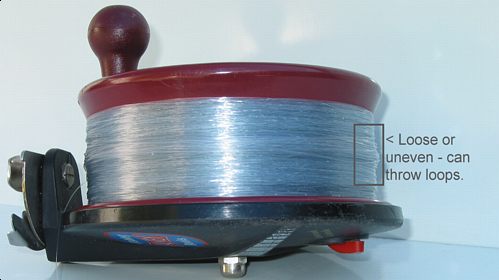
Line wound unevenly and not level on the spool of the Alvey.
"Hills" of line. Any time you forget to keep that index finger moving and wind a lot of line on in one place, it will build up a hill as shown in the photo below - and that's a problem in waiting.
As you cast next time, the line can grab loops of line and drag them off out of order and give a bad tangle. Or the hill can collapse and leave you with loose loops of line on the spool.
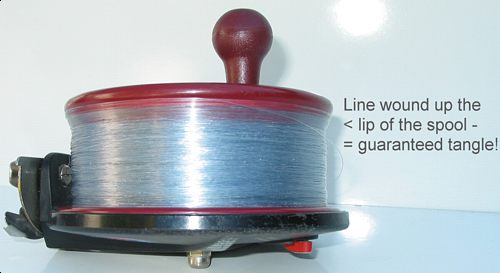
Line wound up the lip of the spool of the Alvey - a tangle disaster in waiting!
Line on the lip of the spool. Another trap new users can fall into is to forget to move the finger and the line just builds up on the lip of the spool as shown in the photo below.
This eventually falls off the face of the spool and that's a disaster because the line tangles around the handles or drag of the reel, or the line falls back off the lip and leaves you with lots of loops of loose line on the spool.
Even if the line doesn't spill off the face, it can cause problems with future casts. Line wound up the lip of the spool is always a disaster in waiting and we recommend that you don't ever cast without fixing that first.
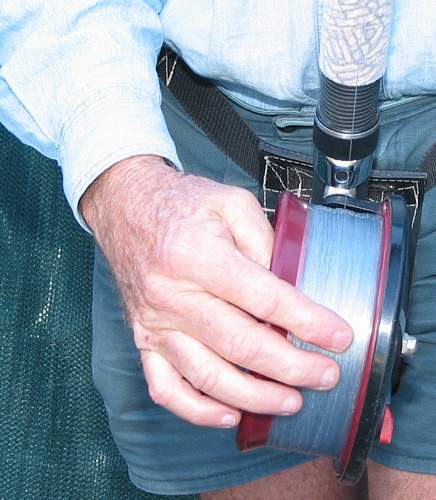
Move your fingers and feel for any problems with the line on the spool.
Too busy to look or too dark to see? OK you ask, "how do I check all this level wind stuff when I'm busy watching the fish, watching the waves or watching where I am standing or walking, or it's too dark to see?"
Easy - use the fingers of your right hand and feel the line on the spool as you turn the handle to rotate the spool. That lets you feel any hills or loose line or line going up the lip of the spool.
You can do this without looking or in the dark and your fingers will easily find any problems.
All these descriptions apply to Alvey reels which are wound with the right hand. Reverse everything if using an Alvey wound with the left hand.
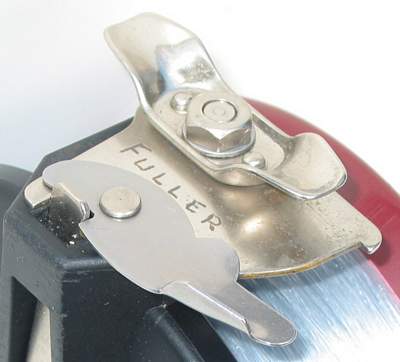
The Alvey spool release lever.
The spool release lever unlocks the spool so that it can be rotated 90 degrees into the casting position.
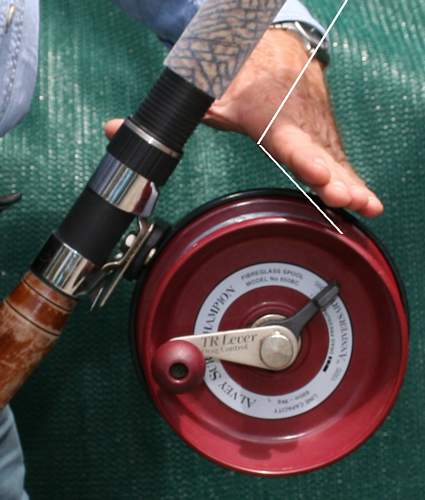
Step 1, line near knuckle on index finger, hand near spool.
Wind the line so that you have the right length of line from the rod tip to the rig or weight. Hold your hand flat and with your thumb stretched out.
Take the line out of the open runner, position the line near the base of your index finger, and run your hand down along the line to the reel so that your thumb ends up on the spool release lever and your fingers are over the lip of the spool.
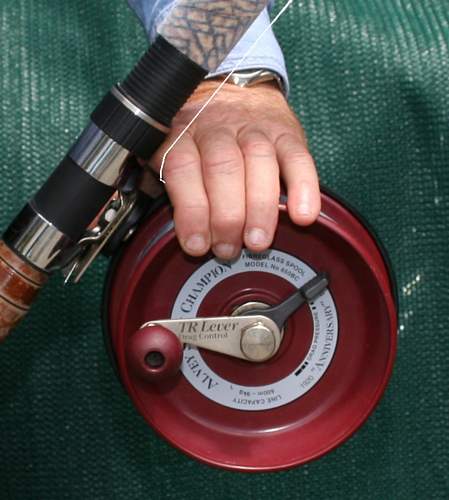
Step 2, fingers on the lip of the spool, thumb on spool release lever.
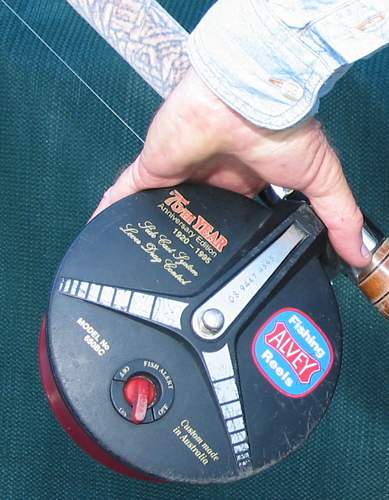
Step 3, Press the spool release lever with the left thumb
Press the release lever with your left thumb, rotate the spool to the casting position.
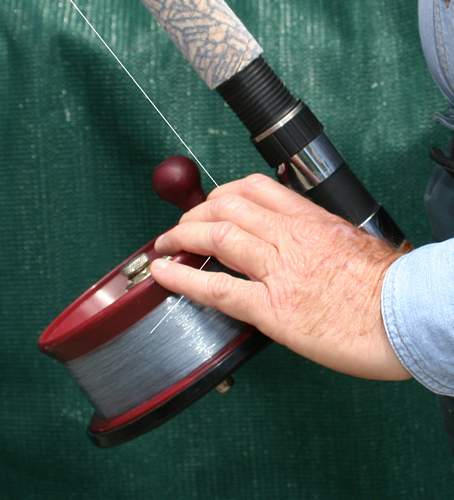
Step 4, Spool turned at right angles to the rod,
fingers still on the lip of the spool.
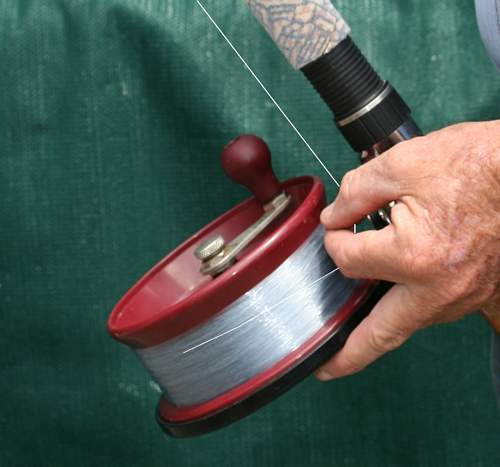
Step 5, transferring line from the finger to the left thumb.
Transfer the line so that it sits on the ball of your thumb.
Grasp and wrap your fingers around the rod below the reel.
Rest your thumb on the metal part or on the spool (see alternatives below) so that you end up with the line passing over or around your thumb at right angles.
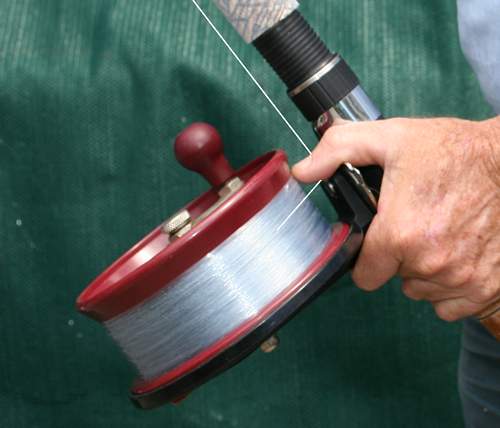
Step 6, One method of holding the rod and the line while casting. (Terry Fuller)
Note the left thumb clamped on to the metal part of the reel seat (but not on the spool), the line over the ball of the left thumb, and the fingers and palm of the hand holding the rod below the reel.
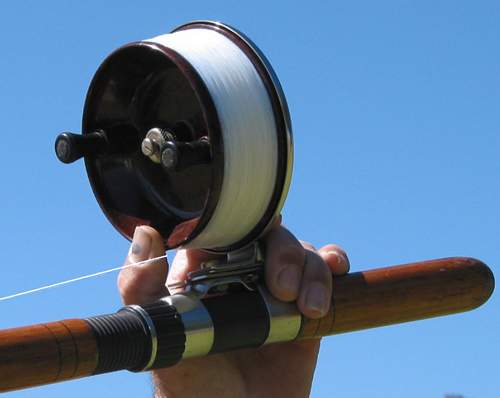
Step 6, Another method of holding the rod and line while casting. (Tony D'Alonzo)
Note the left thumb clamped on to the lip of the spool, and the fingers and palm of the hand holding the rod below the reel.
Now move your right hand up the rod until your arms are a comfortable distance apart, and you are ready to cast.
After the cast, you should end up with your right arm out front of you, and your left hand and the reel down by your left hip, as shown in the photo below of Allan Jones. To get into the line retrieving position, you should:-
1. Place the rod butt in the rod bucket.
2. Turn the reel back into the "normal" position with your left hand.
3. Pick up the line close to the reel, run your hand up and put the line into the open runner.
4. Hold the rod with your left hand below the open runner.
5. Move your right hand down to the reel handle, take up any slack line and wait for the bites......
A lot of casting is done in our windy Western Australian weather where the afternoon winds are south west or southerly and come from 45 degrees to 90 degrees from the left. This happens along most of the West Coast.
These winds can cause lots of problems when casting because they tend to drag more line off the spool at the end of the cast, leading to loose line. Also if you let the line go loose, the wind will blow line off the right hand side of the reel just like the line peels off the spool when casting.
The most important action is to stop any more line feeding out as and after the rig hits the water. The easiest way to do this is use the left thumb to trap the line between the thumb and the lip of the spool. The thumb is an ideal position following Step 6 above.
Warning - do not try to use an Alvey reel on a short rod (less than about 11 feet/3 metres) for casting distances. Do not try to use them on any conventional rod where the reel is mounted 20 inches/550mm or more from the bottom end of the rod. It will not work properly and you will not get any of the benefits but you will get lots of problems.
Alvey reels are best used on long rods (12 to 16 feet/3.6 to 5 metres) and ALWAYS with the reel mounted low down on the rod. These rods are called a "low mount rod" and can also be used for spinning reels and overhead reels, as you can see in many fishing and dry casting photos on our Photos pages where there are many examples of the long rods and "low mounted" reels and the casting action.

Alvey Reel mounted low down on the butt of the rod. Red circle shows position of the open runner.
A rod used with an Alvey reel must have a special "Open runner" fitted about 550 to 600 mm above the reel as shown here.
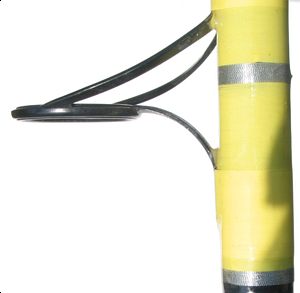
"Upside down" runner, reduces the
chance of the line wrapping around it.
A lot of people now chose the first line guide with a shaped foot and put the first guide on "upside down" as shown because this greatly reduces the chance of a loop of line wrapping around it during a cast.
The guide shown is a 40mm double foot Fuji Alconite guide.
The tip of the rod would be at the top of the photo.
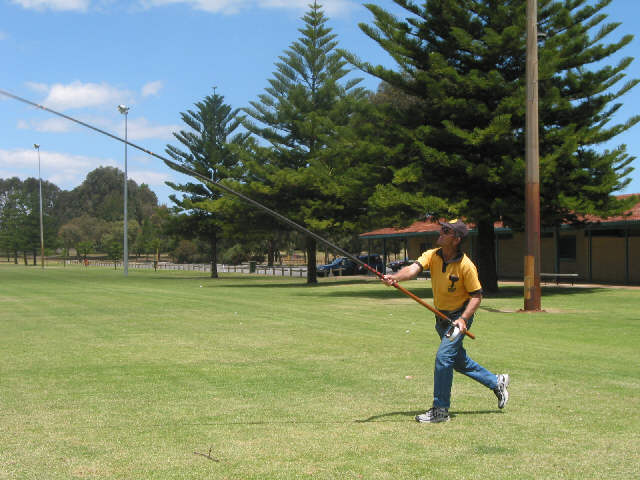
Allan Jones casting for distance with an Alvey reel mounted low down on the butt of the rod.
The casting method is different to that often used with other double handed rods.
For a person whose right hand is dominant, the left hand is on the reel low down and the right hand is 24 to 30 inches/550 to 650mm or more up the rod.
This allows the caster to spread his hands and get the amount of leverage needed to cast the weight.
It allows quite heavy weights and baits to be cast without any strain on the caster.
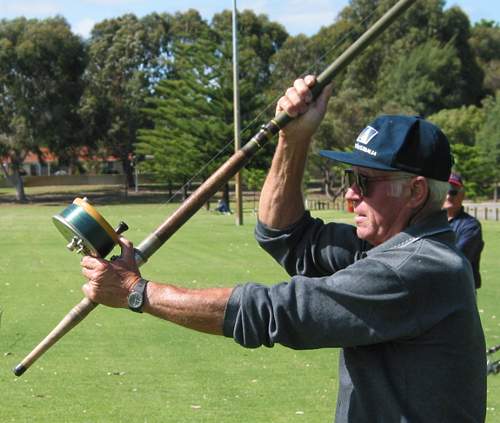
Tony D'Alonzo casting for accuracy with an Alvey reel, clamping the thumb on the spool.
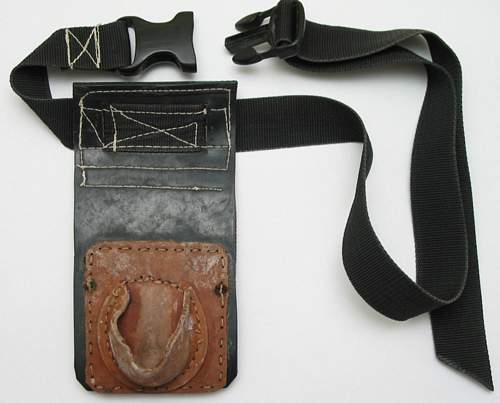
Rod bucket and adjustable belt with a quick release clip.
A rod "bucket" and belt is an essential accessory for fishing with an Alvey reel. Well, maybe not "essential" but after you have used one, you'll never ever fish again without one.
The rod bucket takes all the weight of the rod and reel while you are fishing. It allows you to do the level winding, and leaves your hands free to check rigs, put bait on, manage the line twist.
All you need to do is rest the rod on your left arm and then you have your two hands free to do whatever you need to do without trying to juggle the rod!
(Yes, it's home made and it's old, but it's good!) It's a good idea to fit a quick release clip which allows easy adjustment and makes it easy to slip on a knife scabbard, pliers pouch or a bait bucket.
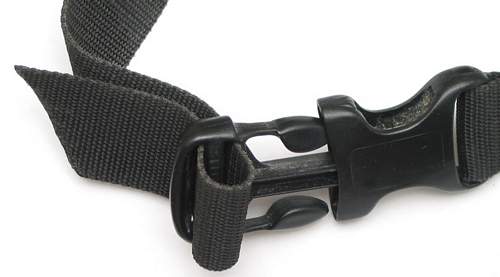
Adjustable quick release buckle clip
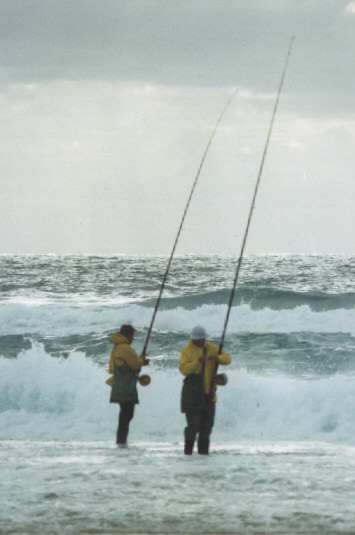
Members fishing with Alvey reels at the Bluff Creek reef
Members fishing with Alvey reels at the Bluff Creek reef.
The angler on the right is checking his rig or putting on a bait.
Note the rod held in the crook of the left arm giving two free hands.
Come to some Club events as a visitor, to our monthly dry casting mornings, fishing trips or general meetings. Read more
Come to a Club event to meet us, then fill out and send us an application for membership plus the nomination fee. The form needs to be signed by you and two financial Club members. Read more

